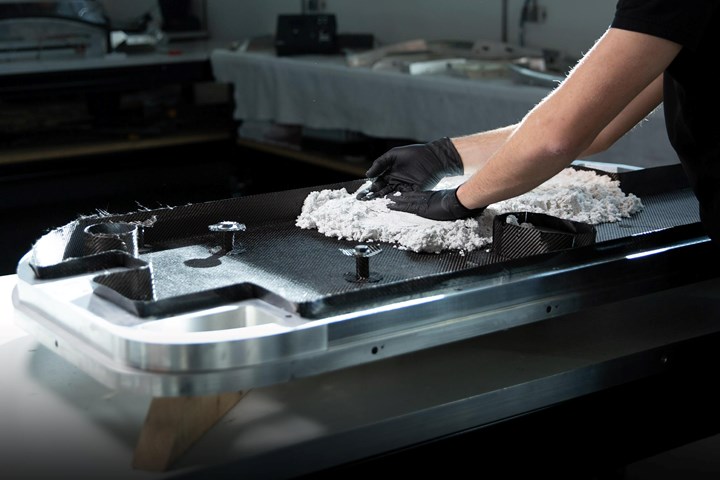Ex-Core Technologies' Ex-Core 2.0 system features intelligent self-heated tooling, custom-mixed core
Debuted at JEC World 2022, Ex-Core 2.0 is said to slash production costs compared to conventional prepreg sandwich processes and produce lighter, stronger parts.

’ (Lelystad, the Netherlands) Ex-Core 2.0, debuted at JEC World 2022 in Paris, France, is a system featuring self-heated aluminum tooling, proprietary software and customizable core to produce stronger, lighter carbon fiber composite parts at reduced production costs compared to conventional prepreg sandwich parts.
Ex-Core Technologies was conceived in 2020 to supply its parent company, carmaker Donkervoort Automobielen (Lelystad), with high-strength, flexibly designed, carbon fiber composite parts. Upon receiving much interest, the company soon began selling its technology to external customers.
As seen in the video below, first, the carbon fiber is laid up in the lower mold. Meanwhile, Ex-Core’s mixing system mixes its “Ex-Core” foam core, which is tailored for the specific application. This core is then spread on top of the fiber in the mold. A self-heated closed mold is used to cure the finished part.
Ex-Core 2.0 is managed by proprietary software that can heat individual tooling segments to different temperatures, to optimize heat transfer to the part.
Removable heating cartridges with integrated monitoring sensors internally heat the Ex-Core 2.0 tooling, while the sensors enable the Ex-Core 2.0 software to control the expansion of the foam as it pressures the carbon fiber layers against the mold.
Ex-Core also now offers its customers a five-step service to go from zero to producing Ex-Core parts themselves: Engineering, prototype production, non-recurring investment in mixing machine and tooling, trailing and standard operating procedure (SOP). This licensing-based business model means the customer only pays one up-front investment for the tooling and the mixing machine, then a price-per-liter for the Ex-Core materials.
Ex-Core 2.0 is said to deliver greater production flexibility, longer life tooling and even more design freedom, capable of zero-radius corners. It also retains Ex-Core’s advantages in sustainability thanks to a reduction in waste materials and trimming
Related Content
-
Plyable releases AI-powered mold design tool
Plyable continues to rid composites engineers of workflow bottlenecks through an end-to-end automated system — from mold design to quotation to manufacturing fulfillment.
-
Jamco America partners with Airtech for 3DP tool recycling
Aerospace manufacturer joins forces with composite materials company to achieve sustainable manufacturing practices that overcome traditional composite layup tooling.
-
VIDEO: Enhancing composite tooling with additive manufacturing
At JEC World 2025, CW editor-in-chief Scott Francis explored the latest advancements in composite tooling with Massivit and Sika.
.jpg;width=70;height=70;mode=crop)





